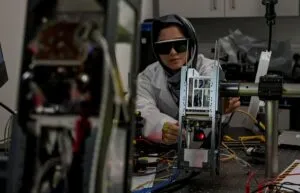It is a dual laser, inter-satellite free-space optical (FSO) communications device. And it aims to provide an alternative to existing low-speed radio frequency (RF) high-power transceivers currently used in CubeSat operations.
The consortium of academic and industry partners includes Northumbria University, Durham University, Telespazio UK, SMS Electronics Limited and Lockheed Martin UK Space. Northumbria’s Professor Eamon Scullion is leading the project.
Northumbria describes it as the UK’s first university-led multi-satellite space mission.
CubeSats
The next phase of ALIGN will involve testing the CubeSats in Northumbria University’s Space Technology Laboratory. This includes facilities such as a thermal vacuum chamber, vibration chamber and X-ray dose testing chamber. There is also a class-4 laser interlocked dark room for optical alignment of the novel laser communications terminal.
The university is planning a test launch of the CubeSats before the end of 2027. And a full commercial launch will follow 2028.
Space
“With the backing of the UKSA we have proved this is not just a concept, we have developed a working prototype,” said Professor Scullion, Principal Investigator of ALIGN.
“Now we are looking for industry, investors and academic experts to help us get this over the line. We’ve built something that works – it’s cutting-edge and competitive. The next stage is to prove it works in space and get it into the commercial market.”
ALIGN
As mentioned, the goal of ALIGN is to support data intensive applications in Low-Earth Orbit (LEO) with an FSO communications device.
According to the university, the system offers adaptable data rates to facilitate a range of end-user requirements. It can transmit and receive simultaneously increasing the effectiveness of data relay in LEO, it says.
The intensity modulation/direct-detection (IM/DD) FSO system uses an infrared laser source. And the system will support link lengths of 500km to 1000km for LEO inter-satellite communications. Data rates can reach up to 1 Gbps (both inter-satellite and satellite-to-ground links).
Investors
With the passing of the testing milestone, however, the university is now looking for further investment. It says it is “inviting investors, partners, and experts to help deliver the final stage of development”. That is, for launching the technology onto the global market.
Northumbria explains that the project has progressed from concept to prototype over the last five years. It originally received staged funding through the UK Space Agency’s National Space Innovation Programme (NSIP). This supports innovative space technologies with the potential to boost the UK’s space capabilities.
Specifically, ALIGN was one of 22 projects for funding in 2020, receiving £360,000 to carry out initial feasibility and design research.
It was then chosen for further funding in 2021, receiving £650,000 to begin building and testing working components. Finally, in January 2023 the project was one of two selected for the third phase of NSIP funding, receiving £5 million to begin preparing flight-ready CubeSats.
Image: Dr Rida Zia-ul-Mustafa, Postdoctoral Research Associate in Free-Space, pictured testing one of the CubeSats
See also: Northumbria University secures £50m for space centre

